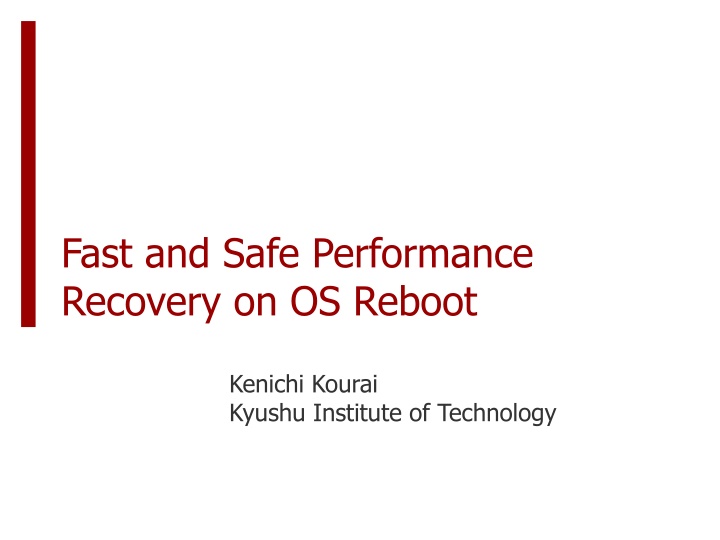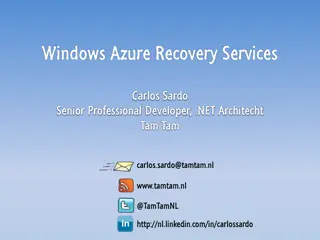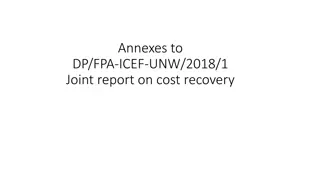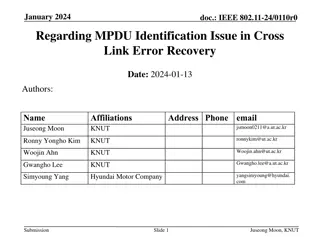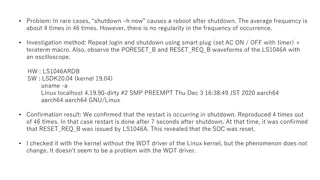Fast and Safe Performance Recovery on OS Reboot
Recovery from OS crashes and performance degradation after reboot are crucial aspects in maintaining system stability. Explore innovative techniques like warm-cache reboot for efficient performance recovery post-reboot and collaboration between OS and VMM for reusing file cache memory.
Download Presentation

Please find below an Image/Link to download the presentation.
The content on the website is provided AS IS for your information and personal use only. It may not be sold, licensed, or shared on other websites without obtaining consent from the author.If you encounter any issues during the download, it is possible that the publisher has removed the file from their server.
You are allowed to download the files provided on this website for personal or commercial use, subject to the condition that they are used lawfully. All files are the property of their respective owners.
The content on the website is provided AS IS for your information and personal use only. It may not be sold, licensed, or shared on other websites without obtaining consent from the author.
E N D
Presentation Transcript
Fast and Safe Performance Recovery on OS Reboot Kenichi Kourai Kyushu Institute of Technology
OS Recovery OS reboot is a final but powerful recovery technique For recovery from OS crashes Against Mandelbugs A rebooted OS rarely crashes again For software rejuvenation Against aging-related bugs A rebooted OS restores its normal state crash reboot recovered OS memory leak reboot
Performance Degradation (1/2) OS reboot degrades the performance of file accesses The file cache on memory is lost Disk access increases due to frequent cache misses It takes long time to fill the file cache Reading file blocks from a disk is slow Most of free memory is used for the file cache file cache slow disk reboot
Performance Degradation (2/2) Disk access also degrades the performance of the other virtual machines (VMs) VMs share a physical disk Frequent disk access occupies the bandwidth Prefetching makes the situation worse Burst of disk access rebooted VM OS VM VM disk
Performance Recovery is Needed OS recovery does not complete until the performance is also recovered Traditional OS reboot restores only the functionalities Fast reboot techniques have been proposed
Warm-cache Reboot A new OS recovery mechanism with fast performance recovery It preserves the file cache during OS reboot An OS can reuse it after the reboot It guarantees the consistency of the file cache Using the virtual machine monitor (VMM) VM discard file cache file cache corrupted cache reboot VMM
Reusing the File Cache Collaboration between an OS and the VMM The VMM re-allocates the same physical memory to a rebooted VM A rebooted OS reserves the memory pages used for the file cache Obtaining meta data from the VMM VM reserve file cache file cache reboot deallocate re-allocate VMM
Cache Consistency Our definition Consistent if the contents of the file cache are the same as those of disks Consistent when a file block is read from a disk Inconsistent when the file cache is modified Consistent when it is written back to a disk read modify write back VM file cache disk
Maintaining Cache Reusability The warm-cache reboot allows an OS to reuse only consistent file cache The VMM is suitable for maintaining the reusability It is isolated from an OS It can mediate all disk accesses It can track all modification to cache pages modify cache pages file cache VM disk VMM
Reusability Management (1/3) The VMM makes a cache page reusable after it reads data from a disk It protects the page before the read To detect page corruption by an OS during the read The VMM can still write data to the page VM possible corruption read request read request VMM protect read reusable read disk
Reusability Management (2/3) The VMM makes a cache page non-reusable before an OS modifies its contents It unprotects the page at the same time To enable the OS to modify the page possible corruption VM unprotect modify request write modify request VMM non-reusable & unprotect
Reusability Management (3/3) The VMM makes a cache page reusable again after it writes data in the page to a disk It protects the page before the write To detect page corruption during the write VM possible corruption write request write request VMM protect write reusable write disk
File Cache and Metadata (1/2) Consistent When data and metadata are written back, or both are not When only metadata are written back E.g. Ext3 writeback mode, Ext2 metadata metadata metadata file cache data memory disk
File Cache and Metadata (2/2) Maybe inconsistent When only data is written back, and When the file size is changed, or When the i-node pointers are changed E.g. Ext3 ordered mode old metadata memory disk
Implementation CacheMind Based on Xen/Linux domain 0 domain U cache The VMM maintains VM memory P2M-mapping table The VMM maintains per-VM data Cache-mapping table Reuse bitmap blkback blkfront Per-VM data VMM disk
Cache-mapping Table A hash table from file blocks to cache pages Domain U adds and removes its entries It looks up matching entries after OS reboot Using hypercalls domain U cache hypercall cache-mapping table VMM
Reuse Bitmap A bitmap for reuseable cache pages Domain 0 sets and clears its bits Using hypercalls The VMM clears its bits When cache pages are unprotected domain 0 domain U cache blkback blkfront hypercall unprotect reuse bitmap VMM disk
Experiments Purposes To show that the warm-cache reboot achieves fast performance recovery File access, web server To confirm that it does not reuse inconsistent file cache fault injection Server CPU: 2 dual-core Opteron Memory: 12 GB Disk: Ultra 320 SCSI NIC: Gigabit Ethernet Client CPU: 2 Core 2 Quad Memory: 4 GB NIC: Gigabit Ethernet
Throughput of File Reads (1/2) We measured the read throughput of a 1-GB file All file blocks were on the file cache normal reboot warm-cache reboot 1400 Our reboot achieved better performance throughput (MB/s) 1200 1000 800 600 16% degradation at maximum 400 200 0 1st 2nd 3rd 4th 5th 6th before reboot after reboot
Throughput of File Reads (2/2) Next, we used a file-backed virtual disk Disk blocks are cached on domain 0 normal reboot warm-cache reboot 1400 throughput (MB/s) 1200 Degradation is mitigated from 90% to 46% 1000 800 600 400 200 0 1st 2nd 3rd 4th 5th 6th before reboot after reboot
Throughput of a Web Server We measured the changes of the throughput during OS reboot 60% degradation for 90 seconds 5% degradation for 60 seconds
Fault Injection (1/2) We measured inconsistent cache reuses We injected various faults into the OS kernel First, we disabled the consistency mechanism 80 The file cache is often corrupted inconsistent reuse (%) 70 60 50 40 no crash process crash kernel crash 30 20 10 0 ALLOC STACK PTR INIT PANIC LEAK COPY TEXT NOP DST LOOP FREE BR I/F
Fault Injection (2/2) Next, we enabled the consistency mechanism Most of reboots did not reuse inconsistent cache Reused file cache was inconsistent only for DST Ext3 failed to write back Faults were injected into ext3 The file cache was not corrupted Reusing it is correct 45 40 inconsistent reuse (%) 35 30 25 disabled enabled 20 15 10 5 0 DST
Related Work Rio File Cache [Chen et al. 96] Reusing dirty file cache after OS crash Relying on an OS RootHammer [Kourai et al. 07] Preserving VMs during VMM reboot Hybrid Hard Drive [Samsung&Microsoft], Turbo Memory [Intel] Including large non-volatile disk cache
Conclusion We proposed the warm-cache reboot It achieves fast performance recovery by reusing the file cache 16% degradation at maximum The VMM maintains consistency of the file cache Consistent, or not-corrupted at least Future work Reducing overheads of protecting cache pages Impact on write performance is large
